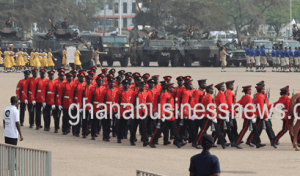Global military spending dips slightly to $1.77 trillion in 2014
 Global military spending dipped marginally in 2014 as cuts by the United States were offset by higher spending in China, Russia and Saudi Arabia, a Swedish-based peace research institute said Monday.
Global military spending dipped marginally in 2014 as cuts by the United States were offset by higher spending in China, Russia and Saudi Arabia, a Swedish-based peace research institute said Monday.
The Stockholm International Peace Research Institute (SIPRI) estimated that global military expenditure totalled 1.77 trillion dollars in 2014, down 0.4 per cent from 2013.
“While total world military spending is mostly unchanged, some regions, such as the Middle East and much of Africa, are continuing to see rapid build-ups that are placing an increasingly high burden on many economies,” said Sam Perlo-Freeman, head of SIPRI’s military expenditure programme.
Despite spending cuts of 6.5 per cent year on year, the US remained the world’s largest spender on 610 billion dollars. That equalled 34 per cent of global expenditures and almost three times as much as second-placed China.
China’s spending increased by 9.7 per cent compared to 2013 to an estimated 216 billion dollars, while third-placed Russia’s outlays rose by 8.1 per cent to an estimated 84.5 billion dollars.
Fourth-placed Saudi Arabia’s spending soared 17 per cent to 80.8 billion dollars, according to the think tank’s estimates.
Saudi Arabia’s spending rise was attributed to regional security concerns and high oil revenues during most of last year.
SIPRI said it remained to be seen whether Saudi Arabia could sustain its spending rates amid falling oil prices, but noted that the country has sizeable financial reserves.
Although Russia has cut planned expenditures for 2015 by 5 per cent, its overall spending was still expected to be higher than in 2014, the report said.
The other top 10 spenders were France, Britain, India, Germany, Japan and South Korea.
Africa remained the region with the highest increase in spending in 2014 – up 5.9 per cent year on year, SIPRI said. Oil and gas producers Algeria and Angola were the region’s top spenders.
In the Middle East, military spending was estimated to have increased by 5.2 per cent. Lebanon and Iraq hiked their spending by 15 per cent, while Oman slashed spending by 20 per cent.
Data was lacking for several countries in the region, including Qatar, Syria and Iran.
In Asia and Oceania, spending rose 5 per cent, mainly driven by China. Australia increased spending by almost 7 per cent after three years of cuts, while India and South Korea made smaller increases.
Indonesia bucked the trend with a 10-per-cent cut that could, however, prove temporary, SIPRI said.
In western and central Europe spending decreased almost 2 per cent compared to 2013, as austerity measures continued, while Eastern Europe saw an 8.4-per-cent increase.
Ukraine increased its spending by over 20 per cent, although most of the increase was for personnel costs and pensions, SIPRI said, underlining that data is incomplete.
The Ukraine crisis has yet to affect overall military spending in the region, although some countries bordering Russia have seen increases, SIPRI said.
In Poland, for instance, military spending rose 13 per cent. This year the country was expected to achieve NATO’s goal of 2-per-cent of GDP allocated to military expenses.
In South America, regional heavyweight Brazil’s military spending dropped slightly, while it rose in Argentina and Paraguay.
Mexico’s spending rose 11 per cent as the military is increasingly deployed in the war on the drug cartels, SIPRI said.
SIPRI said its figures include salaries, costs for operations, purchases of arms and equipment as well as research and development.
The Swedish parliament created SIPRI as an independent foundation in 1966.
Source: GNA
